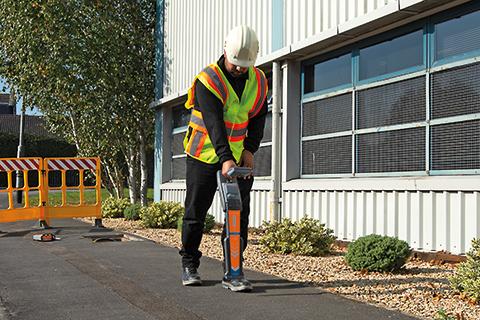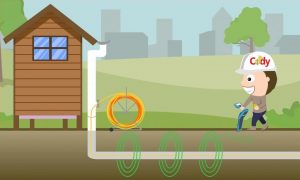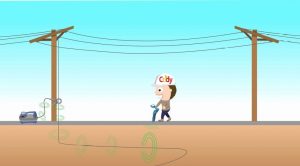Locating Underground Assets And What Locator To Use
This article aims to explain the hidden intricacies of Locating Underground Assets. If you are one of those people and hate reading the full extent of an article and just want the highlights the below is the brief breakdown of what is explained in the article and what models are best suited for Locating particular Underground Cables, Pipes and Conduits.
- Radio Detection RD500 – Underground Poly Water Pipe Locator. A highly specific Underground Locator which is used to locate the most difficult to Locate pipes in Poly Pipes. This is achieved by sending a vibration sound wave into the pipe which travels along the pipe and the Locator is able to track that vibrating Signal.
- Radio Detection RD7200 – Underground Asset locator Range. The RD7200 is a Locator which comes in various forms which are used for locating a range of different Underground Assets, these are listed below for quick reference.
- Radio Detection RD8200 – This Locator is the Locator which covers all the various areas the RD7200 and RD500 dont cover. It takes all the specifications of RD7200 and adds in all the extras. The RD8200 can locate a variety of Underground Assets including the following: Cast Iron Pipes, Concrete Pipes, High Frequency Power Cables, Telecommunication Cables and all Underground Ferrous Metal Pipes. This unit isn’t as specific as the RD7200 but it is a great overall locator which has some additional bonus features.
- Radio Detection RD8200G – The RD8200G is the upgraded version of the standard RD8200 unit. The biggest change to this unit is the addition of the GPS Location element added to the unit. This allows you to not only locate the underground asset but also provide a GPS survey point data in your reports which makes future location of these assets much easier through the use of GPS Location information.
Now that the brief explanation about the recommended systems is out the way continue reading to discover exactly how to locate specific Underground Pipes, Underground Cables and Underground Conduits and how these systems are the perfect choice for what your looking to achieve.
When it comes to excavating these days locating what’s underground before you dig is of massive importance. From Power Cables, Water Pipes, Gas Pipes and Sewer Pipes you can be sure that locating these items before you dig is of high importance otherwise should you strike one of these assets your up for a huge damage cost.
When it comes to purchasing a locating device to locate these assets it becomes even more confusing then it seems. Not matter how much time you put into trying to understand the locating market you can be sure that after a quick look online you will come out even more confused then when you started.
This article aims to help breakdown some of the myths of how locators work and recommend a couple versatile products from Radio Detection that aim to cover the market the best they can.
How do you find underground Sewer Pipes?
The best way to locate anything underground is with an EM (electromagnetic) cable locator. Essentially this equipment transmits a signal into a pipe, and you use your locator to go looking around for the signal. The only problem with this is it requires the pipe to be made of conductive material, otherwise its not capable of carrying the signal through the pipe. There are a few locators on the market capable of Locating Underground Assets such as this.
Most underground sewer pipes are almost always made from non-conductive pipe materials such as;
- PVC
- Vitreous Clay / Earthenware / Terracotta
- Concrete
This makes locating these pipes all that much harder. The best way to overcome this problem is to place a traceable rod into the pipe, these traceable rods are commonly called, Rodder’s, Flexible Tracer Rods or Duct Rods. These are a flexible fibreglass rod that has a copper wire embedded inside it making it conductive.
There are a couple types of these cables which you can purchase on the market. Trace Cables with a 512hz sonde head are cables which only allow you to track the tip of the cable, this is useful for locating Blockages, Pipe Collapses and other issues which you are trying to locate a specific point in the pipe.
Alternatively if your trying to trace the complete pipe to avoid digging it up on a site you will want a Flexible Tracer Rod, this lights up the whole cable along the pipe allowing you to mark the ground where the pipe runs. This cable would require you to connect the tracer wire to your cable Locator’s Transmitter which will induce the cable with a signal allowing your locator to be able to trace the cable along the pipe. Using a Radio Detection RD7200 or RD8200 are the best choice Locators for this application, more to come on this later.
The process to be able to trace Sewer Pipes is as follows.
- Feed the rod into the pipe.
- Transmit the signal into the copper wire embedded in the rod.
- Go and locate the rod.
After reading it in this format it all looks a lot simpler than before, this is where it all gets tricky again. Depending on which pipe your looking to locate is where the changes start to occur. Stormwater, Gas, Power / Telecommunication Cables and Sewer Pipes all have a different way of locating them so let me explain further.
How do you find Underground Storm Water Pipes?
Similarly, to the location of Underground Sewer Pipes finding Storm Water is a tricky exercise. Most of the time these pipes are filled with water to some capacity and require an access point of the pipe to be able to feed in a traceable cable.
Once you have located the beginning, End or Manhole point for the pipe your looking to locate then you can feed in your Flexible Traceable Rod into the pipe just like before, connect your Locator’s Transmitter to the Trace Rod and start locating tracing where the pipe runs.
Like the previous example a Trace Cable with a 512hz sonde can be used but make sure when purchasing one of these Trace Cables that it is in fact IP67 Rated this will stop the water deteriorating the Sonde causing it to breakdown after a short period of time.
The biggest difference between Storm Water and Sewer is the ability to access the pipe itself, should the access point be easy to reach then following these below steps you should be able to trace your pipe quite effectively using a Radio Detection RD7200 or RD8200 Locator, More to come on these Locators later.
The process to be able to Locate Underground Storm Water Pipes is as follows.
- Feed the rod into the pipe.
- Transmit the signal into the copper wire embedded in the rod.
- Go and locate the rod.
How do I Locate Underground Gas Pipes?
This is where it gets very tricky, Gas Pipes are the most common asset which is hit when doing excavation works. The cost of damaging one of these assets is astronomical and makes whatever job your working on take a huge hit in profitability. These assets are the ones you want to locate the most and when locating be the most accurate when tracing them. A quality locator which is built for Locating Underground Assets is essential.
Unlike the Sewer and Storm water pipes you will be unable to locate these pipes with a Flexible Traceable Rod, to locate the Gas pipes effectively a different measure must be undertaken which requires some extra steps to be able to accurately locate the whole pipe across the job.
Whenever you purchase a Pipe / Cable locator you should always look at purchasing with it a set of Inducting Clamps. These clamps induce a current around conductive pipes and allow you to trace that pipe to a certain distance before the current dissipates.
This is 1 method of tracing Gas Pipes you can use on older conductive pipes which are made from Copper or Steel. Basically, you place the induction clamp around an above element of the pipe set your receiver to the correct frequency and start locating the pipe.
The process to be able to Locate Underground Copper or Steel Gas Pipes is as follows.
- Place the inducting clamp around the above ground pipe.
- Connect your transmitter to the clamp and set a frequency.
- Make sure your Locator is set to pick up the same frequency
- Start Locating the Pipe.
Be aware you won’t be able to get the whole pipe, so you’ll have to move up and reconnect your signal clamp further down the pipe.
The problems with tracing Gas pipes comes when you are locating newer gas lines placed down recently, these pipes are usually made from PE Tiger Pipes (A form of Poly Pipe) The good thing with these pipes is as with Australian Regulations the Australian Gas Network has placed a trace wire on the outside of the pipe for locating purposes, all you are required to do is hook your transmitter up to the trace wire match your locator to the same frequency setting and start locating.
This sounds super easy to locate but the problem is most people don’t know about this trace wire that is attached to the outside of the Gas Pipe, You’ll need to dig up a starting section of the pipe, hook into the wire and then you’ll be able to locate the remainder of the pipe effectively.
The process to be able to Locate Underground Poly Gas Pipes is as follows.
- Connect your transmitter to the trace wire on the pipe.
- Select the frequency your wishing to induce the trace wire with.
- Match your locator to same frequency
- Start Locating the Pipe.
Again, just like the previous 2 examples a Radio Detection RD7200 or RD8200 device would be the unit of choice when it comes to being able to locate Underground Gas Pipes.
In the instance that a Poly Gas Pipe doesn’t have a trace cable on it that you can attach your transmitter to and induce a signal along the line it makes tracing this pipe a lot more difficult. Obviously, a call to Dial Before you Dig Is what should be done to discuss the possibility of them having the pipe already mapped out previously. Should this not be the case and the pipes are yet to be located a GPR (Ground Penetrating Radar) Device can be used to locate Underground Gas PVC Pipes. Ill go into more detail about how GPR Systems work a little later.
How Do I Locate Underground Plastic Water Pipes?
Different to the other Underground Poly (PVC) Pipes and Underground Sewer & Stormwater Pipes, Locating Underground Poly Water Pipes is a different beast. This process is best done by using a Transonnde, this device acts to vibrate the water as it passes through it and across an internal spring system sending a minute sound wave back along the pipe. This distinct sound wave is what the locator is looking for and allows you to therefore locate the underground pipe.
To locate a pipe like this it requires a different tool from trying to locate the rest of the Underground Assets previously mentioned, The Radio Detection RD500 is the perfect tool for this job more on this item shortly.
Although the process to locate these pipes is vastly different to all other underground Pipes and Cables you may be trying to locate it is actually a very simple exercise to do.
If you have the right tool for the job locating these pipes is a very easy task but don’t be fooled, without this tool it is most definitely not an easy task. The RD500 device like all Underground Plastic Water Pipe Locators does have limitations. You will be required to move along the pipe every 150M at least as the vibrations dissipate through the water as it travels along the pipe as well as this the depth that this locator works is roughly down to 2M max depth. Any deeper and a GPR (Ground Penetrating Radar) Device will be required.
The process to be able to Locate Underground Plastic Water Pipes is as follows.
- Place the Transonnde on top or near the water pipe
- Set the Frequency to the same as the frequency on the Locator
- Start Tracing the Underground Pipe
- Move the Transonnde down the pipeline as the wavelength dissipates
- Continue Locating the underground pipe
As mentioned before the best tool for this job is the Radio Detection RD500 but should the depth of the pipe be deeper than 2M a GPR (Ground Penetrating Radar) Locator will be required.
How do I Locate Underground Power or Telecommunication Cables?
The final thing you may be looking to locate underground other the previously mentioned pipes are Telecommunication Cables such as, Phone Cables, NBN Cables or Fibre Optic Cables and Underground Power Cables. These cables can be located using those Induction Claps previously mentioned. In essence you would find a point of the cable you are looking to trace such as a Power Cable leading to the house, you would attach your Induction Clamp around the cable and set the induction to a particular frequency on your transmitter. Set your locator to track that frequency and start locating the cable.
These kinds of cables are the easiest to locate out of all the Underground Assets you will need to locate. A good Transmitter is the key thing required here, something that gives you a selection of different radio frequencies to choose from as some cables cause a lot of interference.
This is particularly prominent in Underground Power Cables where they emit a signal of their own at around 50 – 60 Hz. Because of this if you don’t set your inducing frequency to something drastically different you may receive false reading from the frequency dissipating into the surrounding ground which will cause you to be tracing the wrong area.
The best practice when looking to induce an Underground Power Cable is to cycle through the available frequencies from 1Hz to generally 480 Hz. The best thing to remember when doing this is the following statement, “Lower frequencies penetrate the ground better, but higher frequencies give greater definition”. What this means to you is if the cable your trying to locate is really deep into the ground then you will want a lower frequency as the signal will penetrate the earth better and allow you to locate it from the surface, the issue you will face is the cable might only be very thin but the locator will pick up the signal to about a meter either side of the cable itself. Whereas if the cable was located only a short distance underground a higher frequency will give you a much greater definition of accuracy to be able to pinpoint the cables location.
The process to be able to trace Underground Telecommunication & Power Cables is as follows.
- Connect your induction clap to the cable your wanting to locate.
- Select a frequency which you can trace which isn’t being interfered with by the frequency already being emitted by the cable.
- Match your locator to same frequency being induced.
- Start Locating the Pipe.
Again, the best units for this type of locating whether it’s an Underground Telecommunication Cable or Underground Power Cable are the Radio Detection RD7200 & RD8200 devices.
As you tend to do this practice more frequently you will come to find yourself knowing what works best for what your trying to locate. As the old saying goes “practice makes perfect”.
Radio Detection Information
As I mentioned earlier during the how to locate part of this article there were mentions of specific locators in which would be best suited for finding certain Underground Assets. This is where ill break down the specifics for each one mentioned, their capabilities, the different models available and what those changes in models mean to you.
Radio Detection RD8200 – Underground Asset Locator
Radio Detection RD8200 – There are certain applications the RD7200 Series are unable to do and that is where the step up to the RD8200 comes in. The Radio Detection RD8200 is engineered to deliver high precision for damage prevention when locating buried cables and pipes. This advanced range of underground utility locators offers optional integrated GPS and usage logging and is backed with Radio Detections 3 Year Warranty, this is the ultimate Locator for Locating Underground Assets.
Similarly, the RD8200 can have slight modifications added to the Locator to assist in locating specific Underground Assets, but generally the standard RD8200 Covers all the blind spots the RD7200 misses.
The RD8200 comes with 5 Custom Frequency settings (128Hz – 200kHz) it has 4 Sonde frequencies (512Hz – 33kHz), Fault Finding capabilities (8kHz & CD Fault Find) and has 3 Locate modes (Passive Avoidance, Power & Radio).
This makes the RD8200 the upgrade upon the RD7200 within the locator family line-up. Between all these different models there isn’t an Underground Pipe, Cable or Conduit that you will not be able to Locate accurately and effectively.
There is also the RD8200G which is the GPS location version of the RD8200 Locator. All the functions and specifications are exactly the same as RD8200 unit with the addition of the GPS Location element. What this enables you to do is be able to Survey your located assets and provide a detailed survey report for customers, companies and Councils of where your located underground assets are located for future use.
Radio Detection RD7200 – Underground Asset Locator Range
The RD7200 is the baby brother of the RD8200 with a cheaper price point and a few specification changes makes the RD7200 ideal for its area within the market.
The RD7200 has the following specifications, 7 Locate Frequencies, 4 sonde Frequencies, 3 Passive Modes along with Power filers and Compass direction in passive modes. These specifications makes the RD7200 a very good option if you are looking to keep the price of your new system as low as possible and you dont require the crazy high end specifications of the RD8200.
The RD7200 still functions the exact same as the RD8200 using the same antenna layout giving the RD7200 the same level of accuracy as the RD8200 with the only changes being the amount of frequencies the RD7200 has.
Radio Detection RD500 – Underground Poly Water Pipe Locator
First off ill start with the RD500 which is used to locate Underground Water Pipes, this unit is a very specialised unit which can only perform this 1 task. If you spend a lot of your time Locating Underground Water Poly Pipes this is the device, you will require but note that it is only used for this 1 task and nothing else, unfortunately this locator isn’t able to Locating Underground Assets other than Poly Pipes.
The Radio Detection RD500 performs admirably in completing its task though and your results in locating Underground Water Poly Pipes will be exceptional, with the following specifications it covers all bases.
- Simple Operation – A meter deflects showing pick-up of the vibrations on the water pipe
- No Disruption of service while locating.
- Audible and Visual tracing indicator
- Variable Power Pulsars (TransOnde) Supplied
- Distance up to 150 Meters may be traced
- Locate up to 2-meter depth.
Hopefully this article has shed some light on the industry which is generally cloaked in mystery and confusion. If there is anything missed within the article which you require answering you can always call our office and talk with our knowledgeable staff members and discuss exactly what it is your looking to Locate Underground and they will be able to assist in finding the perfect Locator for your application.
For more information about theRadiodetection range of Underground Locators you can view their website here – RadioDetection.




